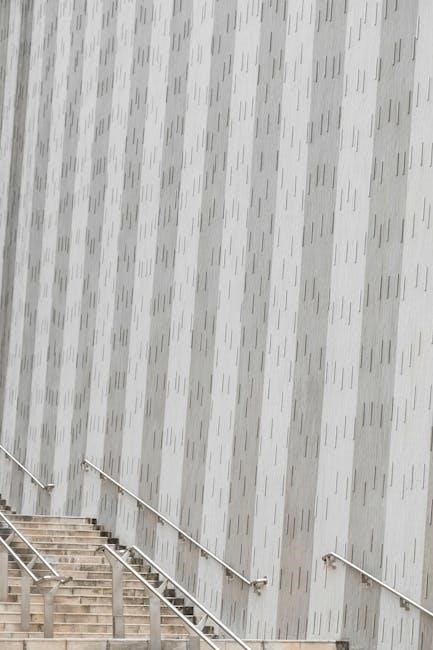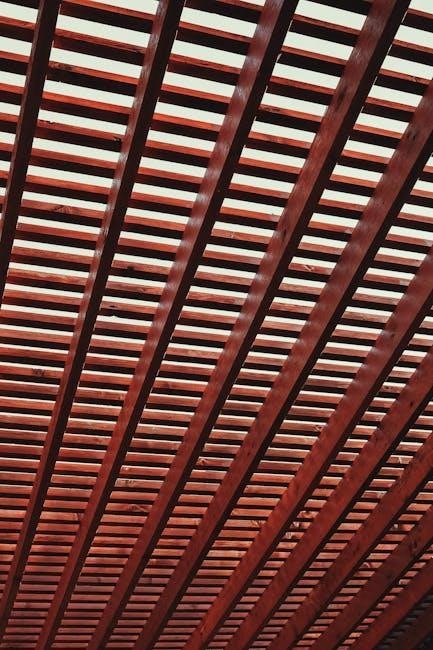
Welcome to our comprehensive worksheet on parallel lines cut by a transversal. This resource offers detailed exercises to identify angle pairs and solve problems using congruent and supplementary angle properties, perfect for mastering geometry concepts.
Overview of the Topic
Understanding the relationships between parallel lines and transversals is a fundamental concept in geometry. When a transversal intersects two parallel lines, it forms eight angles with specific properties. These angles can be classified into pairs such as corresponding, alternate interior, and alternate exterior angles. The worksheet provides a structured approach to identifying and solving problems involving these angle pairs. By practicing with the exercises, students can master the theorems related to congruent and supplementary angles. The resource is designed for students in grades 6-9, offering a clear and engaging way to grasp the essential principles of parallel lines and transversals.
Importance of Understanding Parallel Lines and Transversals
Mastering the concept of parallel lines cut by a transversal is essential for building a strong foundation in geometry. It introduces students to angle relationships, such as corresponding, alternate interior, and alternate exterior angles, which are critical for solving complex problems. Understanding these principles enhances spatial reasoning and problem-solving skills, which are vital in real-world applications like architecture, engineering, and navigation. Additionally, this knowledge prepares students for advanced topics in mathematics and science. By practicing with worksheets, students can develop precision and confidence in applying geometric theorems, ensuring a solid understanding of fundamental concepts that are used throughout their academic and professional careers.

Basic Concepts of Parallel Lines and Transversals
Parallel lines never intersect and are cut by a transversal, forming key angle pairs like corresponding, alternate interior, and alternate exterior angles, essential for geometric problem-solving.
Definition of Parallel Lines
Parallel lines are straight lines in a plane that never intersect, no matter how far they are extended. They maintain a constant distance apart and have equal slopes. This fundamental concept is crucial for understanding the properties of angles formed when a transversal intersects them. The definition of parallel lines serves as the foundation for identifying corresponding, alternate interior, and alternate exterior angles. These relationships are essential for solving problems involving angle congruence and supplementary angles. By mastering the basics of parallel lines, students can better understand the theorems and properties related to transversals and their applications in geometry. Regular practice with worksheets helps reinforce this key concept.
Definition and Role of a Transversal
A transversal is a straight line that intersects two or more parallel lines. Its primary role is to create pairs of angles with specific relationships, such as corresponding, alternate interior, and alternate exterior angles. The transversal’s intersection with parallel lines forms eight angles, which are organized into these distinct pairs. The properties of these angles, such as being congruent or supplementary, are fundamental to solving geometry problems. The transversal serves as a visual tool to demonstrate and apply the theorems related to parallel lines, making it essential for understanding and working with angle relationships in various geometric scenarios. Regular practice with worksheets helps students master these concepts effectively.

Angle Pairs Formed by Parallel Lines and Transversals
When a transversal intersects parallel lines, it forms corresponding, alternate interior, alternate exterior, and same-side angles, each with unique properties essential for solving geometric problems.
Corresponding Angles
Corresponding angles are pairs of angles formed when a transversal intersects two parallel lines. These angles are located in the same relative position in relation to the lines and the transversal. According to the Corresponding Angles Postulate, if two parallel lines are cut by a transversal, the corresponding angles are congruent. This means they have equal measures. For example, if one corresponding angle measures 45 degrees, its pair will also measure 45 degrees. Identifying corresponding angles is crucial for solving problems involving parallel lines and transversals, as they provide a foundation for understanding other angle relationships. Practice identifying and solving for corresponding angles using our free PDF worksheets.
Alternate Interior Angles
Alternate interior angles are pairs of angles formed by a transversal intersecting two parallel lines. They are located inside the parallel lines but on opposite sides of the transversal. According to the Alternate Interior Angles Theorem, these angles are congruent when the lines are parallel. This theorem is a direct consequence of the properties of parallel lines and is essential for solving various geometry problems. Identifying alternate interior angles is a key skill, as they help in determining the relationships between different angles formed by the transversal and the parallel lines. Our PDF worksheets provide ample practice in identifying and solving problems involving alternate interior angles, ensuring a solid understanding of this fundamental concept.
Alternate Exterior Angles
Alternate exterior angles are pairs of angles formed outside the parallel lines but on opposite sides of the transversal. These angles are non-adjacent and lie outside the space between the parallel lines. According to the Alternate Exterior Angles Theorem, these angles are congruent when a transversal intersects two parallel lines. Identifying alternate exterior angles is crucial for understanding angle relationships in geometry. Our PDF worksheets include exercises to identify and solve problems involving alternate exterior angles, helping students master this concept through hands-on practice. These resources are designed to reinforce the properties of parallel lines and transversals effectively.
Same-Side Interior and Exterior Angles
Same-side interior angles are two angles located on the same side of the transversal and inside the parallel lines, forming a linear pair. These angles are supplementary, meaning their measures add up to 180 degrees. Similarly, same-side exterior angles are located on the same side of the transversal but outside the parallel lines. These angles are also supplementary, as they form a linear pair. Understanding the relationships between same-side interior and exterior angles is essential for solving problems involving parallel lines cut by a transversal. Our PDF worksheets provide exercises to identify and solve for these angles, ensuring a solid grasp of their properties and applications in geometry.

Properties of Angles Formed by Parallel Lines Cut by a Transversal
Parallel lines cut by a transversal create congruent corresponding, alternate interior, and alternate exterior angles. Same-side interior angles are supplementary, aiding in solving angle problems effectively.
Congruent Angles Theorems
The congruent angles theorems state that when parallel lines are cut by a transversal, specific angle pairs are equal in measure. Corresponding angles, found in matching positions relative to the lines, are always congruent. Similarly, alternate interior angles and alternate exterior angles, located on opposite sides of the transversal, are also congruent. These theorems rely on the parallel nature of the lines and the consistent angles formed by the transversal. By applying these properties, students can solve for unknown angles and prove geometric relationships. Understanding these theorems is fundamental for working with parallel lines and transversals in various geometric problems and proofs.
Supplementary Angles Theorem
The supplementary angles theorem states that when two parallel lines are cut by a transversal, the sum of the measures of same-side interior angles and same-side exterior angles is 180 degrees. This means that if one angle in the pair is known, the other can be found by subtracting its measure from 180 degrees. This theorem is crucial for solving problems involving parallel lines and transversals, as it helps in determining unknown angles and verifying the relationships between them. By applying this theorem, students can efficiently solve for missing angle measures in various geometric configurations.

Classifying Angle Pairs
Angle pairs formed by parallel lines and transversals include corresponding, alternate interior, alternate exterior, and same-side angles. Classifying these pairs helps identify their relationships and properties effectively.
Identifying Corresponding Angles
Corresponding angles are those located in the same relative position across parallel lines cut by a transversal. For example, if two lines are parallel and a transversal intersects them, the angles formed in the same upper or lower positions on each line are corresponding angles. These angles are critical in geometry because they are always congruent when the lines are parallel, making them a fundamental concept in solving various angle problems. By identifying corresponding angles, students can apply the Corresponding Angles Postulate to determine angle measures and relationships in different geometric scenarios. This skill is essential for more advanced geometry topics.
Identifying Alternate Interior and Exterior Angles
Alternate interior angles are formed inside the two parallel lines on opposite sides of the transversal, while alternate exterior angles are outside. Identifying these angles is crucial for applying the Alternate Interior Angles and Alternate Exterior Angles Theorems, which state that these angles are congruent when the lines are parallel. By recognizing and classifying these angle pairs, students can solve for unknown angle measures and establish relationships between angles in various geometric configurations. This skill enhances understanding of parallel lines and transversals, making it easier to tackle more complex geometry problems effectively.

Solving Problems Involving Parallel Lines and Transversals
Apply theorems and properties of parallel lines to identify angle pairs and solve for unknown angles using corresponding, alternate, and supplementary relationships effectively in geometric problems.
Step-by-Step Guide to Solving Angle Problems
Identify the Angle Pairs: Begin by labeling the diagram and identifying whether the angles are corresponding, alternate interior, alternate exterior, or same-side interior/exterior angles. Understanding their positions relative to the transversal and parallel lines is crucial for applying the correct theorems.
Apply Theorems: Use the appropriate theorem based on the identified angle pair. Corresponding angles and alternate interior/exterior angles are congruent, while same-side interior angles are supplementary (sum to 180 degrees).
Set Up Equations: If solving for an unknown angle, set up an equation using the known angle and the identified relationship (e.g., corresponding angles are equal, or same-side interior angles add up to 180 degrees).
Solve for the Unknown Angle: Use algebraic methods to solve the equation and find the measure of the unknown angle.
Verify the Solution: Ensure the calculated angle is reasonable within the context of the problem and does not contradict geometric principles.
By following these steps systematically, you can effectively solve angle problems involving parallel lines cut by a transversal.
Examples of Solving for Unknown Angles
Example 1: In a diagram with parallel lines cut by a transversal, if one corresponding angle measures 45 degrees, the other corresponding angle is also 45 degrees (since corresponding angles are congruent).
Example 2: If alternate interior angles are 30 degrees and 150 degrees, they are supplementary. Thus, 30 + 150 = 180 degrees, confirming the same-side interior angles theorem.
Example 3: To find an unknown angle, set up an equation using known angles. For instance, if two alternate exterior angles are 60 degrees and an unknown angle, solve for the unknown using the congruence of alternate exterior angles.
These examples demonstrate how to apply geometric theorems to solve for unknown angles efficiently.

Parallel Lines Cut by a Transversal Worksheet PDF Resources
Access free printable PDF worksheets and premium resources to practice solving angle problems involving parallel lines and transversals, available online for download.
Free Printable Worksheets
Discover a wide range of free printable PDF worksheets designed to help students master parallel lines and transversals. These resources offer comprehensive practice in identifying angle pairs, such as corresponding angles, alternate interior angles, and same-side interior angles. Worksheets include exercises to solve for unknown angles, classify angle relationships, and apply theorems. Many are available through platforms like Infinite Geometry, KutaSoftware, and Math Worksheets Land. Print them conveniently for classroom use or homeschooling. These free resources provide an excellent way to reinforce geometry skills and ensure a deep understanding of parallel lines and transversals. Start your practice today!
Premium and Paid Resources
Premium and paid resources offer advanced tools and comprehensive materials for mastering parallel lines and transversals. Platforms like KutaSoftware and Infinite Geometry provide paid subscriptions with additional features, such as customizable worksheets, interactive lessons, and detailed solution guides. These resources often include video tutorials, step-by-step explanations, and access to a library of practice problems. Paid options are ideal for educators seeking structured lesson plans or students needing in-depth support. While free worksheets are available, premium resources offer enhanced learning experiences, making them a valuable investment for serious geometry study. Explore these paid tools to elevate your understanding and problem-solving skills in parallel lines and transversals.

Using Worksheets Effectively
Maximize learning by approaching problems methodically, checking solutions, and reviewing mistakes. Regular practice with worksheets enhances understanding and retention of parallel lines and transversals concepts effectively.
How to Approach Practice Problems
When solving problems involving parallel lines and transversals, start by identifying the angle pairs formed. Use the properties of corresponding angles, alternate interior angles, and alternate exterior angles to establish relationships. For each problem, carefully label the angles and determine which theorem applies. If solving for an unknown angle, set up an equation based on the identified angle pair and solve step-by-step. Practice classifying angles as corresponding, alternate interior, or alternate exterior to strengthen your understanding. Regular review of solutions and mistakes will improve accuracy. Utilize free PDF worksheets and online tools for additional practice and mastery of these geometry concepts.
Time Management and Strategy for Worksheets
Start by breaking down the worksheet into manageable sections, focusing on one concept at a time. Allocate 10-15 minutes per problem set to maintain focus. Use a timer to avoid spending too much time on a single question. Review the relevant theorems before starting, such as corresponding angles or alternate interior angles. Skim through the worksheet to identify problem types and prioritize easier ones first. Work systematically, starting with simpler angle identification before moving to complex calculations. Show all steps clearly and check your work periodically. If stuck, refer to answer keys or solutions for guidance. Take short breaks to stay refreshed and maintain accuracy.

Real-World Applications of Parallel Lines and Transversals
Parallel lines and transversals are essential in architecture for designing symmetrical structures, navigation for mapping routes, and engineering for ensuring railway tracks and roadways remain parallel and safe.
Architecture and Design
In architecture, parallel lines and transversals are fundamental for creating symmetrical and balanced designs. Builders use these principles to ensure structural integrity, such as in the alignment of beams or columns. Architects leverage corresponding and alternate angles to design visually appealing facades and interiors. For instance, parallel lines in flooring patterns create a sense of continuity, while transversals add depth and texture. Understanding these geometric relationships helps professionals achieve precision and aesthetics in their designs, making spaces more functional and visually striking. These concepts are also applied in urban planning to create grid layouts and aligned roadways, enhancing navigation and accessibility.
Navigation and Mapping
Parallel lines and transversals play a crucial role in navigation and mapping. They are used to create grid systems, ensuring alignment and accuracy in maps. For instance, roads and pathways often follow parallel lines, while transversals like streets or trails intersect them, forming clear intersections. This helps in determining directions and distances. Understanding angle relationships, such as corresponding and alternate angles, aids in plotting courses and interpreting map symbols. These concepts are essential for GPS systems, maritime navigation, and hiking trail designs. By applying parallel line properties, cartographers create visually organized and functional maps, making navigation more intuitive and efficient for users.

Interactive Activities and Games
Engage with interactive tools and games to visualize and explore parallel lines cut by a transversal. These activities offer hands-on learning, making geometry fun and accessible for all students.
Online Tools for Visualizing Parallel Lines and Transversals
Utilize online tools like Infinite Geometry and KutaSoftware to create interactive diagrams and worksheets. These platforms allow students to visualize parallel lines and transversals, explore angle relationships, and solve problems dynamically. Features such as drag-and-drop lines and real-time angle measurements enhance understanding. Many tools also provide step-by-step solutions and video tutorials, making complex concepts accessible. Interactive simulations help students identify corresponding, alternate interior, and exterior angles, reinforcing theoretical knowledge with practical application. These resources are ideal for both classroom and self-study, ensuring a deeper grasp of geometry fundamentals in an engaging and efficient manner.
Educational Games for Better Retention
Educational Games for Better Retention
Educational games offer an engaging way to reinforce concepts of parallel lines and transversals. Interactive activities like puzzles, quizzes, and angle-matching games make learning fun and competitive. Tools such as Infinite Geometry and KutaSoftware provide dynamic simulations where students can explore angle relationships firsthand. These games often include timers and score tracking, motivating students to improve their problem-solving skills. By practicing in a gamified environment, learners retain information more effectively and develop a stronger understanding of corresponding, alternate interior, and exterior angles. Such interactive approaches ensure that geometry concepts are not only learned but also retained for long-term academic success.
This concludes our exploration of parallel lines cut by a transversal. Key concepts, such as angle pairs and properties, were covered to enhance understanding and problem-solving skills. Keep practicing for mastery!
Encouragement for Further Practice
Consistent practice is key to mastering parallel lines and transversals. Use the provided worksheets to reinforce your understanding of angle relationships, such as corresponding, alternate interior, and same-side angles. Exploring interactive tools and educational games can make learning engaging and fun. Apply these concepts to real-world scenarios, like architecture or navigation, to see their practical value. Remember, geometry is a skill that improves with patience and effort. Regular practice will build your confidence and problem-solving abilities. Keep challenging yourself with new problems and enjoy the progress you make in understanding these fundamental geometric principles!